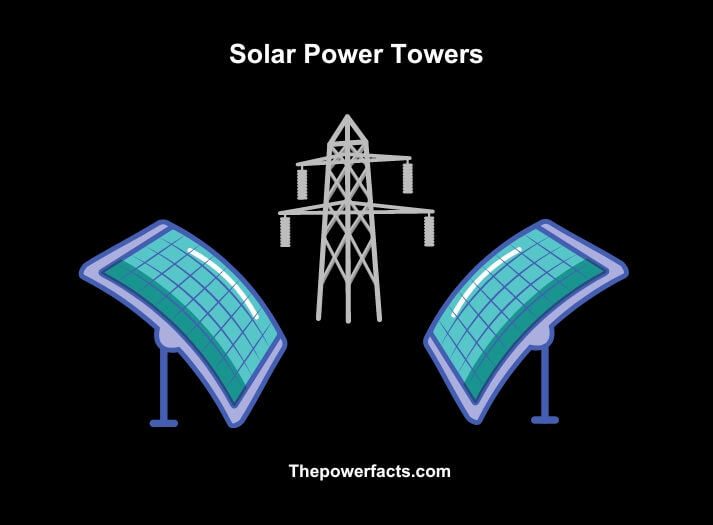G’day, folks! Have you ever heard about the mighty “Solar Power Towers”? If not, then buckle up, because we’re about to embark on an electrifying journey exploring these towering titans of renewable energy. These colossal structures are transforming the way we harness the sun’s power, making our world a cleaner and greener place to live. So, without further ado, let’s delve into the ins and outs of solar power towers and discover what makes them the future of renewable energy.

The Lowdown on Solar Power Towers
What on Earth are Solar Power Towers?
Solar power towers, also known as central receiver systems, are an innovative solar energy technology that utilizes an array of mirrors, called heliostats, to concentrate sunlight onto a central receiver located atop a tall tower. The concentrated sunlight is then used to generate electricity by heating a fluid, typically molten salt or water, which powers a steam turbine. In a nutshell, these big ol’ towers are like giant magnifying glasses that focus sunlight to produce electricity.
The Nuts and Bolts of Solar Power Towers
To get a better understanding of how solar power towers work, let’s break down their main components:
- Heliostats: These are the adjustable mirrors that follow the sun’s movement, reflecting and concentrating sunlight onto the central receiver.
- Central Receiver: Situated atop the tower, this crucial component absorbs the concentrated sunlight, heating the fluid contained within.
- Heat Transfer Fluid (HTF): Usually molten salt or water, the HTF absorbs heat from the central receiver and transfers it to the power generation system.
- Power Generation System: The heated HTF is used to generate steam, which drives a turbine connected to a generator, producing electricity.
Perks of Solar Power Towers
These solar sentinels have several advantages over traditional photovoltaic (PV) panels:
- Higher efficiency: Solar power towers boast higher efficiency than PV panels, thanks to their ability to concentrate sunlight and generate electricity even on cloudy days.
- Energy storage: Molten salt storage systems allow solar power towers to continue generating electricity long after the sun has set, providing a reliable energy source around the clock.
- Scalability: The modular nature of solar power towers allows for easy expansion, making them suitable for large-scale power generation projects.
Solar Power Towers: A Bright Future
Current Projects and Progress
Solar power towers have been making headlines in recent years, with several high-profile projects showcasing their potential. Here are a few noteworthy examples:
- Ivanpah Solar Electric Generating System (USA): Boasting a capacity of 392 MW, Ivanpah is the largest solar power tower facility in the world.
- Noor III (Morocco): This 150 MW solar power tower is part of Morocco’s ambitious plan to generate 42% of its electricity from renewable sources by 2020.
- Gemasolar (Spain): A shining example of thermal energy storage, Gemasolar can store enough energy to operate 24/7 during the summer months.
The Road Ahead for Solar Power Towers
As the world continues to grapple with climate change and dwindling fossil fuel reserves, solar power towers are poised to play an increasingly significant role in our energy mix. With ongoing research and development, we can expect to see further improvements in efficiency, cost-effectiveness, and energy storage capacity, making solar power towers an even more compelling option for large-scale power generation.
FAQs
How much land is required for a solar power tower facility?
The amount of land required for a solar power tower facility depends on the size and capacity of the project. Generally, larger installations require more land to accommodate the heliostats and the tower. On average, a 100 MW solar power tower facility may need about 1,000 acres of land.
Are solar power towers environmentally friendly?
Yes, solar power towers are environmentally friendly as they produce clean, renewable energy without emitting greenhouse gases or generating toxic waste. However, their construction and operation may have some environmental impacts, such as land and water use, which can be minimized through careful planning and mitigation measures.
How do solar power towers compare to other renewable energy sources in terms of cost?
The cost of electricity generated by solar power towers is generally higher than that of traditional photovoltaic systems. As technology improves and economies of scale come into play, the cost is expected to decrease. When compared to other renewable energy sources, solar power towers have advantages such as higher efficiency and the potential for energy storage, which can make them more cost-competitive in the long run.
Can solar power towers generate electricity at night?
Solar power towers with molten salt storage systems have the ability to generate electricity even after the sun sets. The stored thermal energy can be used to produce steam and generate electricity, providing a continuous and reliable power supply around the clock.
Conclusion
In conclusion, solar power towers are an exciting and innovative renewable energy technology with the potential to reshape the way we generate electricity. Their unique ability to concentrate sunlight, store thermal energy, and provide reliable power around the clock makes them a promising solution to the world’s growing energy demands.
As research and development continue to push the boundaries of what solar power towers can achieve, we can look forward to a future powered by cleaner, greener, and more sustainable energy sources. And who knows, one day we might see solar power towers dotting the landscape, standing tall as the towering titans of renewable energy!